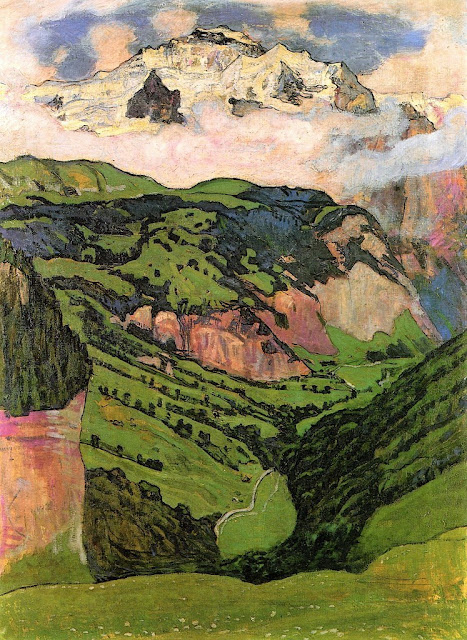FERDINAND HODLER (1853-1918)
The Jungfrau (4,158 m - 13, 642 ft)
Switzerland
In The Jungfrau from Isenfluh, oil on canvas, 1902, Kunstmuseum Basel
The mountain
The Jungfrau (4,158 m - 13,642 ft) ("The virgin" in german) is one of the main summits of the Bernese Alps, located between the northern canton of Bern and the southern canton of Valais, halfway between Interlaken and Fiesch. Together with the Eiger and Mönch, the Jungfrau forms a massive wall overlooking the Bernese Oberland and the Swiss Plateau, one of the most distinctive sights of the Swiss Alps. It is one of the most represented by artists summits with the Matterhorn and the Mont Blanc. The summit was first reached on August 3, 1811 by the Meyer brothers of Aarau and two chamois hunters from Valais. The ascent followed a long expedition over the glaciers and high passes of the Bernese Alps. It was not until 1865 that a more direct route on the northern side was opened. The construction of the Jungfrau railway in the early 20th century, which connects Kleine Scheidegg to the Jungfraujoch, the saddle between the Mönch and the Jungfrau, made the area one of the most-visited places in the Alps. Along with the Aletsch Glacier to the south, the Jungfrau is part of the Jungfrau-Aletsch area, which was declared a World Heritage Site in 2001.
The Jungfrau (4,158 m - 13,642 ft) ("The virgin" in german) is one of the main summits of the Bernese Alps, located between the northern canton of Bern and the southern canton of Valais, halfway between Interlaken and Fiesch. Together with the Eiger and Mönch, the Jungfrau forms a massive wall overlooking the Bernese Oberland and the Swiss Plateau, one of the most distinctive sights of the Swiss Alps. It is one of the most represented by artists summits with the Matterhorn and the Mont Blanc. The summit was first reached on August 3, 1811 by the Meyer brothers of Aarau and two chamois hunters from Valais. The ascent followed a long expedition over the glaciers and high passes of the Bernese Alps. It was not until 1865 that a more direct route on the northern side was opened. The construction of the Jungfrau railway in the early 20th century, which connects Kleine Scheidegg to the Jungfraujoch, the saddle between the Mönch and the Jungfrau, made the area one of the most-visited places in the Alps. Along with the Aletsch Glacier to the south, the Jungfrau is part of the Jungfrau-Aletsch area, which was declared a World Heritage Site in 2001.
Politically, the Jungfrau is split between the municipalities of Lauterbrunnen (Bern) and Fieschertal (Valais). It is the third-highest mountain of the Bernese Alps after the nearby Finsteraarhorn and Aletschhorn, respectively 12 and 8 km away. But from Lake Thun, and the greater part of the canton of Bern, it is the most conspicuous and the nearest of the Bernese Oberland peaks; with a height difference of 3,600 m between the summit and the town of Interlaken. This, and the extreme steepness of the north face, secured for it an early reputation for inaccessibility.
The landscapes around the Jungfrau are extremely contrasted. Instead of the vertiginous precipices of the north-west, the south-east side emerges from the upper snows of the Aletsch Glacier at around 3,500 metres. The 20 km long valley of Aletsch on the south-east is completely uninhabited and also surrounded by other similar glacier valleys. The whole area constitutes the largest glaciated area in
In 1811, the brothers Johann Rudolf and Hieronymus Meyer, the head of a rich merchant family of Aarau, with several servants and a porter picked up at Guttannen, reached the summit for the first time.
The painter
Ferdinand Hodler was one of the best-known Swiss painters of the 19th century. His early works were portraits, landscapes, and genre paintings in a realistic style. Later, he adopted a personal form of symbolism he called Parallelism.
In the last decade of the nineteenth century his work evolved to combine influences from several genres including Symbolism and Art Nouveau. In 1890 he completed Night, a work that marked Hodler's turn toward symbolist imagery. It depicts several recumbent figures, all of them relaxed in sleep except for an agitated man who is menaced by a figure shrouded in black, which Hodler intended as a symbol of death. Hodler developed a style he called "Parallelism" that emphasized the symmetry and rhythm he believed formed the basis of human society. In paintings such as The Chosen One, groupings of figures are symmetrically arranged in poses suggestive of ritual or dance.
Hodler painted number of large-scale historical paintings, often with patriotic themes. In 1897 he accepted a commission to paint a series of large frescoes for the Weapons Room of the Schweizerisches Landesmuseum in Zurich. The compositions he proposed, including The Battle of Marignan which depicted a battle that the Swiss lost, were controversial for their imagery and style, and Hodler was not permitted to execute the frescoes until 1900.
Hodler's work in his final phase took on an expressionist aspect with strongly coloured and geometrical figures. Landscapes were pared down to essentials, sometimes consisting of a jagged wedge of land between water and sky.
2018 - Wandering Vertexes...
Un blog de Francis Rousseau
2018 - Wandering Vertexes...
Un blog de Francis Rousseau
